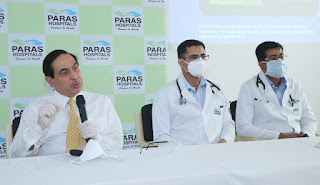Using this latest technique the team of leading interventional cardiologist and Chairman Cardiac Sciences Dr HK Bali at Paras Multi speciality Hospital and his team have successfully operated upon a 70 years old female patient.
Dr Rana Sandeep Singh Director CTVS, Dr Kapil Chattree Sr. Consultant Cardiology, Dr Gagan Deep Singh Consultant Cardiology and Dr Priyanka Gupta, Consultant Cardiac Anesthesia from Paras Super Specialty Hospital, Panchkula were present with him during the media briefing held regarding this.
He explained that aortic stenosis — occurs when the heart's aortic valve narrows. This narrowing prevents the valve from opening fully, which reduces or blocks blood flow from your heart into the main artery to your body (aorta) and onward to the rest of your body thereby creating severe health issues for heart patients.
Speaking on the occasion Dr H K Bali said that with an experience of more than 30 years in Cardiology and having conducted over 15000 cardiac interventions, he had performed this surgery ten days ago. This is first case of non surgical valve-in-valve replacement procedure. With this the Paras Hospital has become first private Hospital in Tricity to start Non-Surgical Valve in Valve Replacement procedure.
He added that procedure was conducted on a 70 year old Female patient who had undergone Surgical Valve replacement in heart about 6 yrs ago. Dr Bali said that "Percutaneous aortic valve replacement is a new treatment option for heart patients of critical aortic stenosis, in whom surgical risk is very high as it carries increased morbidity. This is the first case of non-surgical Valve in valve replacement in this region and comes as a boon to patients of North India.
He added that elderly patients suffering from this critical disease would benefit greatly by this technology. This Non-Surgical Valve replacement is done from the groin and the patient can become completely active next day after the procedure. This is a completely non-surgical technique and the groin site is repaired non-surgically immediately after the procedure.
The procedure lasted 2.5 hours and was completely successful. Patient has made a complete recovery and has become mobile from the second day after the procedure.
Dr. Bali cited the case of 70 old patient from Chandigarh Mohali who was having symptoms of severe breathlessness even during minimal day to day activities. On investigating, it was found that the old Aortic Valve which was replaced about 9 yrs back had degenerated and was causing symptoms of breathlessness. The patient was seen by a team of Cardiologists and Cardiac Surgeons and it was decided that there was a very high risk in doing a Redo Surgical Valve replacement ( Re SAVR).
After detailed examination and discussion, the heart team decided to perform Non-Surgical Trans cutaneous Aortic Valve replacement as the best treatment option to the family. Dr Bali said with this the Hsopital has performed second Case of TAVR in Panchkula.
The first case was done by Dr Bali and his team at Paras Hospital about 6 weeks back. The procedure Lasted for Two and half Hours and was successful. The patient had made complete recovery and had become mobile on 2nd day itself.
Dr Bali shared that in India as of today, around 600 TAVI cases are done annually, whereas in USA approx 80000 thousand TAVI cases are done annually.
He added that TAVR or TAVI – Transcutaneous Aortic Valve replacement is a type of Non-Surgical treatment. This offers a New ray of hope for high risk & moderate risk patients, who need Aortic Valve replacements. As it avoids the risk of Open-Heart surgery, Prolonged anaesthesia and long recovery period. This is a US FDA approved technique which has been evaluated worldwide over the last 10 yrs with large clinical trials in High surgical risk patients. It is proven to be a safer technique than surgical aortic valve replacement in this patient subst.


Nonsurgical Treatment for spine issues Kerala
ReplyDelete